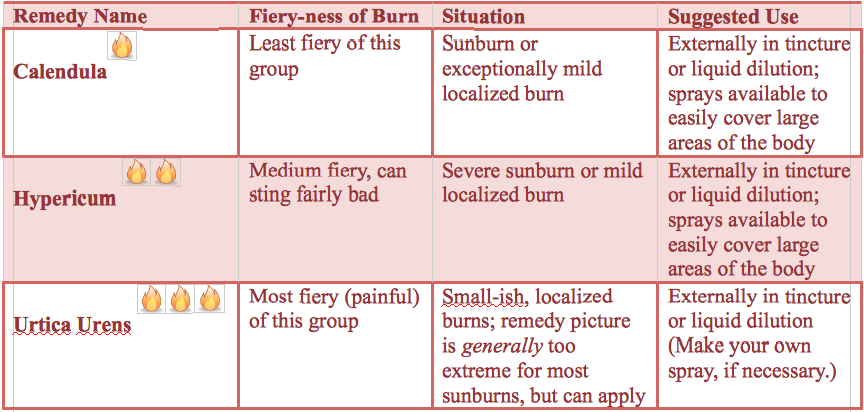
Summer may not officially begin until the solstice later this month but the school calendar and weather here in Central Texas already have many of us thinking of vacation, favorite swimming holes and tons of outdoor activities. Hopefully, we are also thinking of the strength of the summer sun and how to protect our skin from increased exposure.
But even the best of plans occasionally go astray and miss a spot with the sunscreen. If so, let homeopathy come to the rescue. Typically, sunburn is a first (or second) degree burn from exposure to the radiation of the sun, and the common symptoms include redness, pain, swelling, and warmth of the affected skin. Blisters, general fatigue or mild dizziness may also occur. Itching, peeling or rash may become part of the picture as the condition develops.
Extreme sunburns and cases of sun poisoning can require hospitalization. But most sunburns are considered mild injuries and are appropriate for home care. Homeopathic medicines can have benefits both externally and internally. The main external (topical) remedies are Calendula, Hypericum and Urtica Urens, listed here from least fiery sensation to most. Apply the remedy as soon as possible after the burn occurs, and reapply as needed over the next few days. For many burns appropriate for home care, this may be all the treatment that is needed.
Both Calendula and Hypericum are widely available in pump spray bottles of liquid dilution, which are perfect for covering the large areas commonly affected in sunburn. And since these products are dilutions of the tinctures, the alcohol content is low enough that they do not sting when applied to open areas where blisters may have popped. Urtica is not typically available in this convenient form, but you can easily make your own by diluting one part of the mother tincture with three parts of clean water and putting it in a sterile pump spray bottle.
As long as the burn continues to heal, the external remedies can be used for pain relief, to speed healing of the tissues, and to prevent or minimize scarring.
The main internal remedies for burns are Urtica Urens, Cantharis and Causticum. Beginning as soon as possible after the injury, give one dose every 15 minutes until the pain subsides or for three to six doses. After the initial round, the remedy may be given for continued pain relief and healing – three to four times per day for a few days. As always, stop giving the remedy when symptoms have improved.
The simplest differentiation between the three main internal remedies reads more like a conventional text than a homeopathic one:
– First degree burn ► Urtica Urens
– Second degree burn ► Cantharis
– Third degree burn1 ► Causticum
While this differentiation sneaks up dangerously close to using homeopathic remedies in an allopathic way (which can not be endorsed!), this simplistic division will lead to effective treatment in most cases. Cantharis is known to be able to prevent blisters (blisters indicate second-degree burn) if given early enough. Urtica Urens does not have any special relationship to blistering and may excel at the true first-degree burn (which isn’t severe enough to blister.) And Causticum is a mineral remedy with a special affinity to deep burns.
The healthiest advice about sunburn is to avoid it; it is uncomfortable, damaging, and sets the stage for more serious problems later on. According to the Mayo Clinic, even a single sunburn can increase your risk of future complications such as dry, wrinkled skin, liver spots, actinic keratoses, and skin cancer, including melanoma. But on those occasions when it is already too late for prevention, consider homeopathy to help restore the skin to the healthiest level possible, as soon as possible.
by Lorri Anderson, CCH
Classical Homeopath at Peoples S. Lamar

